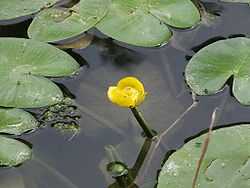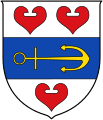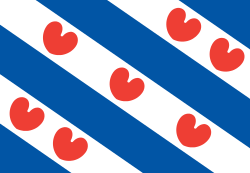Seeblatt


Seeblatt (German: 'sea leaf') is the term for the stylized leaf of a water lily, used as a charge in heraldry.[1]
This charge is used in the heraldry of Germany, the Netherlands and Scandinavia, but not so much in the Anglophone countries. There are seeblatts in the coat of arms of Denmark.
In Frisian, the term pompeblêd is used. The name is used to indicate the seven red lily leaf-shaped blades on the Frisian flag. The seven red "pompeblêden" (leaves of the yellow water lily and the European white waterlily) refer to the medieval Frisian 'sea countries': autonomous regions along the coast from Alkmaar to the Weser. There have never been exactly seven of these administrative units, the number seven probably has the connotation of 'many'. Some sources do assume seven Frisian countries: West Friesland, Westergoa, Eastergoa, Hunsingo, Fivelingo, Emsingo and Jeverland.
Examples
-

Tecklenburg, Germany
-

Original arms of the German counts of Tecklenburg
-

The Frisian flag
Sources
- ↑ Mistholme: Seeblatt, retrieved on 18 Feb. 2015
See also
- Flag of Friesland (province)
- Heart (symbol)
- Cardioid, a geometrical curve resembling the outline of a seeblatt